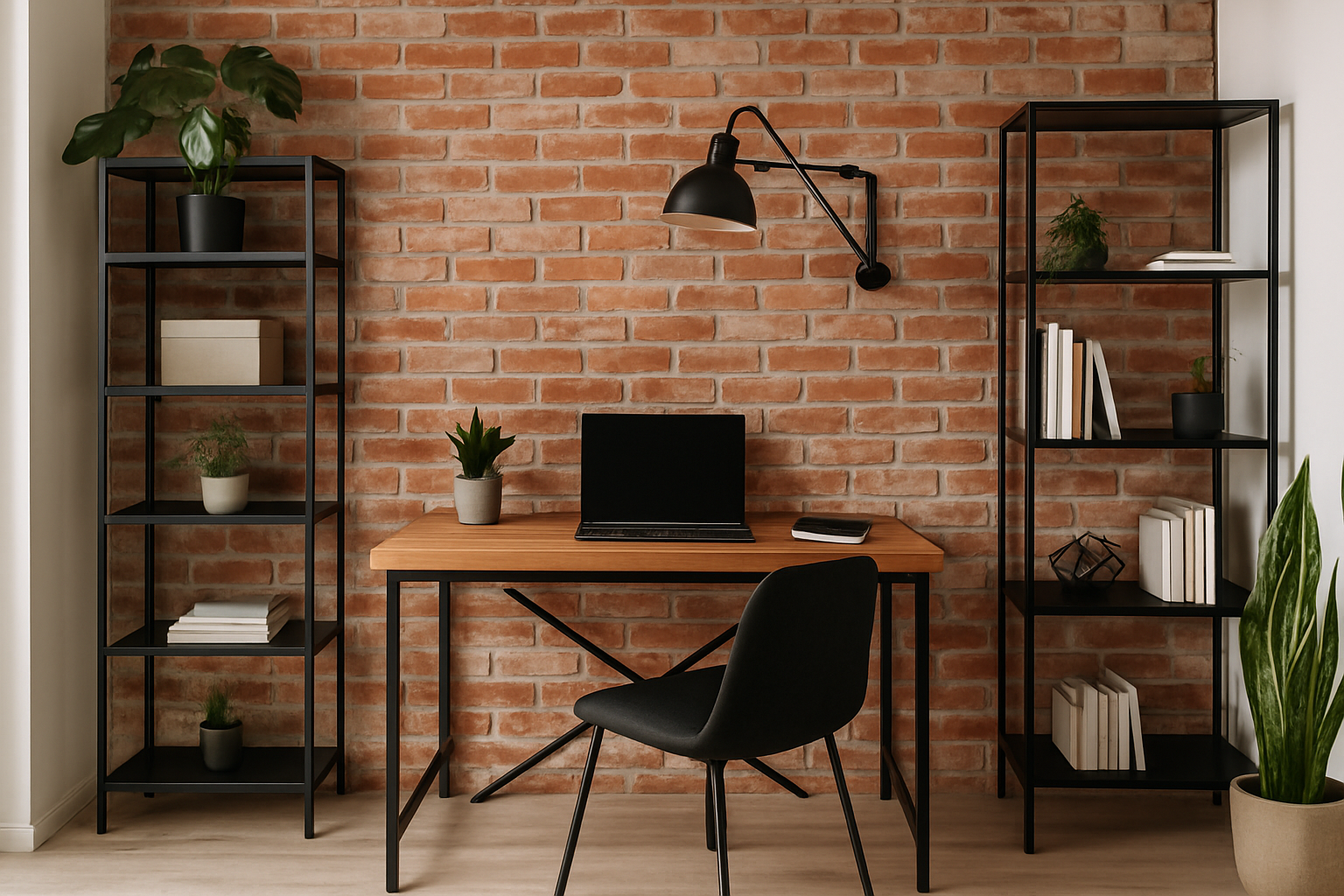Industrial style is bold, raw, and edgy—yet surprisingly practical and elegant, even in small apartments. Born from converted warehouses and factories, this design trend embraces unfinished materials, minimalist layouts, and functional beauty. When adapted thoughtfully, it works beautifully in compact homes and home offices alike.
In this article, you’ll discover how to decorate with industrial flair—using the right mix of texture, color, furniture, and layout to make a small space feel open, structured, and stylish.
1. Stick to a Neutral, Muted Color Palette
Industrial interiors are grounded in grays, blacks, whites, and earthy tones. These shades evoke a factory feel while keeping your space feeling open.
Recommended colors:
- Charcoal, slate, and concrete gray
- Matte black or gunmetal
- Beige, sand, or camel
- Hints of rust, brick, and burnt orange
Use darker colors sparingly in small rooms—balance with white or pale tones to avoid a cave-like effect.
2. Embrace Raw Materials
One of the hallmarks of industrial design is its unapologetic use of raw and unfinished materials.
Core materials:
- Exposed brick (or faux brick wallpaper)
- Concrete (real or painted finishes)
- Steel or black iron
- Reclaimed wood
- Leather (especially aged or distressed)
These textures create contrast and depth in small areas without needing lots of decorative items.
3. Choose Simple, Functional Furniture
Form follows function in industrial style. Furniture should be straightforward, solid, and purposeful—with clean lines and minimal ornamentation.
Great choices:
- Metal-framed desks or tables
- Wood-and-pipe open shelving units
- Leather chairs with exposed seams
- Industrial-style stools or chairs with rivets or wheels
Look for pieces that combine steel and wood for the ultimate industrial vibe.
4. Use Open Shelving to Avoid Bulk
In a small apartment, bulky cabinets can overwhelm the space. Instead, opt for open shelving that keeps the room light while adding visual interest.
Tips:
- Try black metal brackets with wood planks
- Use pipe shelving for an authentic feel
- Style shelves with a mix of books, boxes, tools, and plants
Open shelves double as storage and decor—perfect for multifunctional spaces.
5. Add Statement Lighting
Lighting is key to nailing the industrial look. Opt for fixtures that feel industrial, utilitarian, or reclaimed.
Lighting styles:
- Dome-shaped pendant lights
- Black cage lights or Edison bulbs
- Wall-mounted swing-arm lamps
- Floor lamps with exposed wiring or riveted joints
Metal and matte finishes like black, brass, or copper work best in this style.
6. Incorporate Industrial Accents in the Office
If you’re blending a home office into your industrial space, the look should stay consistent.
Office decor ideas:
- Wire baskets or trays for papers
- Clipboards or metal wall organizers
- Chalkboard or matte black memo boards
- Steel desk lamps and vintage pencil holders
Functional accessories that match your materials keep everything cohesive.
7. Blend Industrial with Minimalism
Small spaces benefit from simplicity. Avoid cluttering your industrial base with too many vintage props or distressed elements.
Keep it clean:
- Use only 2–3 materials throughout the room
- Maintain a limited color palette
- Leave negative space around furniture and walls
This lets the industrial elements stand out without feeling heavy or chaotic.
8. Go Vertical with Design Elements
Make use of vertical space to avoid crowding the floor.
Ideas:
- Tall, narrow shelving
- Pegboards with metal hooks
- Art hung from metal rails or clips
- Floor-to-ceiling curtains in neutral or gray tones
Tall pieces draw the eye upward and make ceilings feel higher.
9. Mix in Soft Textures for Balance
Industrial can sometimes feel too cold or rigid. Soften the space with contrasting textures.
Suggestions:
- Woven rugs or kilims in neutral tones
- Linen or cotton drapes
- Knitted throws or pillows
- Canvas art or framed fabric panels
A few soft materials go a long way toward comfort and livability.
10. Feature One Bold, Raw Element
Industrial spaces often have one standout material or feature that anchors the entire room.
Examples:
- A faux brick accent wall
- A concrete desktop or coffee table
- A metal-framed glass partition
- A large black-and-white photo in a raw wood frame
Let this element speak loudly—then build everything else around it subtly.
11. Use Industrial Decor Sparingly
It’s easy to over-theme with “industrial.” You don’t need factory clocks, faux gears, or exposed ductwork in a small space.
Focus on:
- Materials and finishes over themed objects
- Functionality with subtle nods to the style
- Quality over quantity
This keeps the look elevated and avoids kitsch.
12. Make Use of Found or Repurposed Items
Industrial style celebrates reuse and authenticity. Incorporate vintage or salvaged pieces when possible.
Try:
- A reclaimed wood desktop
- Old filing cabinets
- Repurposed toolboxes for storage
- Metal crates as side tables
These elements add story and character to your space.
13. Add Greenery to Soften the Look
Plants balance the rawness of industrial design beautifully.
Ideal choices:
- Snake plant or ZZ plant in metal pots
- Pothos trailing from a shelf
- Succulents in terracotta bowls
- Ferns for softness and volume
Choose planters in black, rust, gray, or matte finishes to stay on theme.
Decorating a small space with industrial style is all about balance: raw but refined, bold but minimal, functional but beautiful. With smart furniture choices, vertical layouts, and a few key materials, you can make even the most compact apartment feel like a sophisticated urban loft.
Let your space showcase character, craftsmanship, and practicality—without overcomplicating the design. Industrial doesn’t mean harsh—it means honest, grounded, and full of purpose.

